In April of 2013, more than 50,000 digitized records on the vertebrate fauna of Bolivia, the result of nearly 30 years of scientific research by the Natural History Museum Noel Kempff Mercado (MHNNKM) and its collaborators, became available to the public and specialists in the first Geospatial Center for Biodiversity of Bolivia (El Centro Geoespacial para la Biodiversidad de Bolivia – CGB). JRS is proud to provide partial support the CGB’s development, more information see the Natural History Museum Noel Kempff Mercado project page.
The CGB website, which includes geographical and spatial distribution, natural history and conservation data on vertebrates, amphibians, birds, mammals, fish, and reptiles, is designed to be an informational source available to people of all levels of education to view and generate new information. Biologist, researcher and project leader, Kathia Rivero, explains that “[the website] is designed so that a student with some knowledge of pre-degree information can access and understand the information they require for their research.” There will also be different levels of access to generate more and newer informatio” and while any visitor can access the data entered into the Geospatial Center for Biodiversity, a special researcher account must be acquired in order to generate more information.
The hope for the CGB is that is can bring together research institutions, conservationists, and local and national authorities together to contribute and use the information to help support biodiversity conservation in Bolivia. The data obtained from the GCB can be generated into a map and overlaid over existing maps to highlight different issues of conservation. To view these maps, please visit the CGB’s Geo-Vertebrates website:
To learn more about this project, please visit the Geospatial Center for Biodiversity website at: http://www.museonoelkempff.org/cgb/

